Table of content
- 1 From Offal to Opulence
- 2 Culinary History: Waste Not, Want Not
- 3 The Philosophical Underpinnings
- 1 The Cleaning Ritual: Patience as a Virtue
- 2 Marination: The Flavor Foundation
- 3 The Wok: A Theater of Heat
- 1 Sichuan: Fiery Boldness
- 2 Guangdong: Subtlety and Precision
- 3 Shandong: The Heartiness of the North
- 1 Street Food Soul
- 2 Festive Feasts
- 3 Global Adaptations
- 1 Nutritional Profile
- 2 Safety Concerns
- 1 Gourmet Innovations
- 2 Vegetarian and Vegan Twists
Introduction: The Uncelebrated Hero of Chinese Cuisine
Chinese cuisine is a tapestry woven from centuries of tradition, innovation, and an unwavering reverence for ingredients—even those overlooked by other cultures. Among these, stir-fried pig intestine, or baochao dachang, stands as a testament to the culinary ingenuity that transforms humble, often-maligned components into dishes of profound complexity and delight. This article embarks on a journey through the sizzling woks and aromatic alleys of China to explore the art, history, and cultural resonance of this beloved dish. From its humble origins as a street food staple to its elevation in gourmet circles, stir-fried pig intestine is more than a meal—it is a narrative of resilience, craft, and the enduring human desire to find beauty in the ordinary.
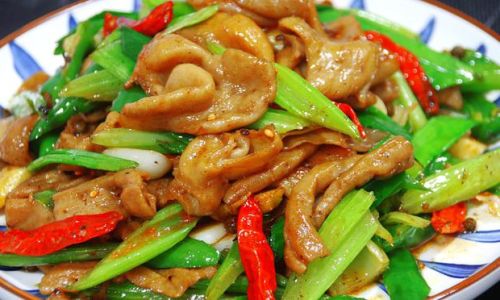
Chapter 1: The Anatomy of a Delicacy
1 From Offal to Opulence
Pig intestine, classified as offal or variety meats in Western contexts, has long been revered in Chinese gastronomy as a treasure trove of texture and flavor. Unlike tender cuts of meat, the intestine’s rugged, tubular structure demands meticulous preparation and a mastery of heat. When cooked correctly, it transforms into a symphony of crispy edges and tender interiors, offering a contrast that tantalizes the palate.
2 Culinary History: Waste Not, Want Not
The dish’s roots trace back to an era when frugality was not a choice but a necessity. In ancient China, peasants and chefs alike learned to honor every part of the animal, turning scraps into sustenance. Over time, what began as a practical solution evolved into a culinary art form. By the Ming Dynasty (1368–1644), recipes for stir-fried intestine began appearing in cookbooks, praised for their ability to “elevate the mundane to the magnificent.”
3 The Philosophical Underpinnings
In Chinese philosophy, the concept of yinyang—the balance of opposing forces—permeates cuisine. Stir-fried intestine embodies this duality: the chewiness of the intestine contrasts with the crispness of vegetables; the pungency of garlic and ginger harmonizes with the earthy richness of the meat. It is a dish that celebrates imperfection, reminding diners that beauty lies in contrast and transformation.
Chapter 2: The Alchemy of Preparation
1 The Cleaning Ritual: Patience as a Virtue
Preparing pig intestine is a labor of love. The process begins with a meticulous cleaning ritual to eliminate odors and impurities. Artisans often use a combination of salt, vinegar, and flour, scrubbing the intestine’s interior to strip away residual fats and membranes. Some chefs swear by soaking the intestine in water infused with citrus peels or rice wine, a step that not only cleanses but also imparts a subtle fragrance.

2 Marination: The Flavor Foundation
Once cleaned, the intestine is marinated in a blend of soy sauce, Shaoxing wine, cornstarch, and white pepper. This step is critical: the cornstarch tenderizes the meat, while the wine neutralizes any lingering gaminess. Modern variations might include oyster sauce or five-spice powder, adding layers of umami and warmth.
3 The Wok: A Theater of Heat
Stir-frying demands precision. The wok must be scorching hot, its surface glazed with oil that shimmers but does not smoke. The intestine is added in batches to prevent steaming, ensuring each piece sears rather than stews. The chef’s wrist flicks, tossing the ingredients in a rhythmic dance, while aromatics like ginger, garlic, and dried chilies explode in the heat, releasing their essential oils.
Chapter 3: Regional Variations Across China
1 Sichuan: Fiery Boldness
In Sichuan Province, stir-fried intestine becomes a vehicle for mala—the numbing spiciness of Sichuan peppercorns and dried chilies. Chefs here often pair the intestine with celery or lotus root, their crunch providing textural relief from the heat. A finishing splash of black vinegar adds a tangy counterpoint, balancing the dish’s intensity.
2 Guangdong: Subtlety and Precision
Cantonese chefs approach the dish with a lighter touch. The intestine is stir-fried with ginger, spring onions, and a hint of oyster sauce, the flavors allowed to mingle without overwhelming the meat’s inherent taste. Some recipes incorporate fermented black beans (douchi) for depth, while others garnish with crispy fried garlic chips.
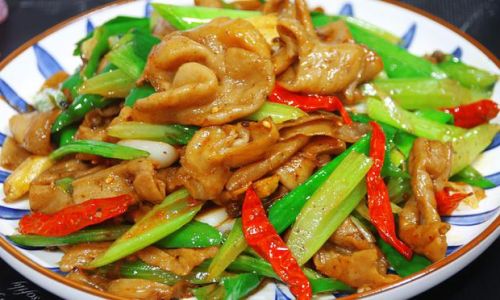
3 Shandong: The Heartiness of the North
In Shandong, a province known for its robust flavors, the dish takes on a heartier character. Thick slices of intestine are stir-fried with wood ear mushrooms, bamboo shoots, and a generous pour of soy sauce, resulting in a dish that is as comforting as it is flavorful.
Chapter 4: The Cultural Tapestry
1 Street Food Soul
In bustling night markets from Beijing to Guangzhou, stir-fried intestine is a star attraction. Vendors wield woks over portable burners, their sizzling creations drawing crowds hungry for a taste of tradition. The dish is often served with steamed buns or rice, its affordability making it a favorite among laborers and late-night revelers alike.
2 Festive Feasts
During Chinese New Year, stir-fried intestine graces banquet tables as a symbol of prosperity and resourcefulness. Its presence reminds families of the importance of humility and gratitude—values embedded in the act of honoring every part of the animal.
3 Global Adaptations
As Chinese cuisine gains global traction, stir-fried intestine has found admirers far beyond Asia. In London’s Chinatown, chefs fuse the dish with Western ingredients like butter or Worcestershire sauce, while in New York, food trucks offer “intestinal tacos” topped with pickled vegetables. These adaptations spark debates among purists but underscore the dish’s adaptability.
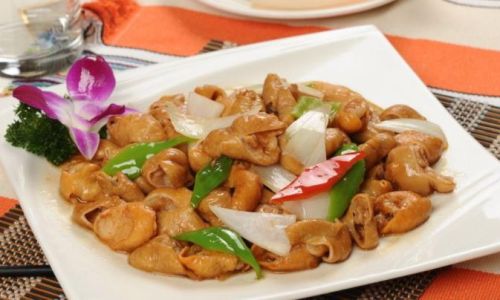
Chapter 5: Health and Nutrition
1 Nutritional Profile
Pig intestine is a rich source of protein, vitamin B12, and iron. However, it is also high in cholesterol and fat, prompting moderation. Nutritionists often recommend balancing it with fiber-rich vegetables to mitigate these effects.
2 Safety Concerns
Proper cooking is non-negotiable. Undercooked intestine can harbor bacteria like Salmonella, making thorough searing essential. Many chefs advocate a two-step cooking process: blanching the intestine before stir-frying to ensure safety without sacrificing texture.
Chapter 6: The Modern Renaissance
1 Gourmet Innovations
Fine-dining restaurants now reinterpret the dish with avant-garde techniques. Some chefs dehydrate and powder the intestine to create crispy garnishes, while others pair it with foie gras or truffle oil. These experiments, though controversial, reflect the dish’s enduring relevance.
2 Vegetarian and Vegan Twists
In response to dietary shifts, plant-based versions using wheat gluten or mushrooms mimic the intestine’s texture. While purists may scoff, these alternatives introduce the dish’s essence to new audiences.

Chapter 7: The Philosophical Legacy
Stir-fried pig intestine is more than sustenance—it is a metaphor. It speaks to the human capacity to find joy in simplicity, to transform the mundane into the magical. In a world obsessed with novelty, it whispers a timeless truth: true mastery lies not in seeking exotic ingredients but in honoring the familiar with reverence and creativity.
Conclusion: A Dish That Defies Time
From ancient kitchens to Michelin-starred restaurants, stir-fried pig intestine endures. It is a dish of contradictions—humble yet luxurious, rustic yet refined. As chefs and diners continue to reimagine its possibilities, one thing remains certain: the sizzle of the wok, the aroma of garlic, and the chew of perfectly cooked intestine will forever hold a place in the heart of Chinese cuisine. To savor it is to taste history, culture, and the alchemy of fire and flavor.

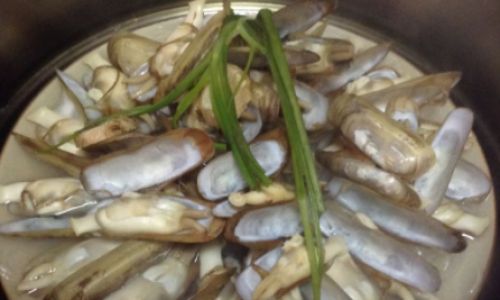
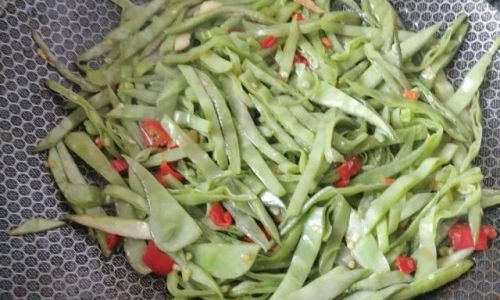
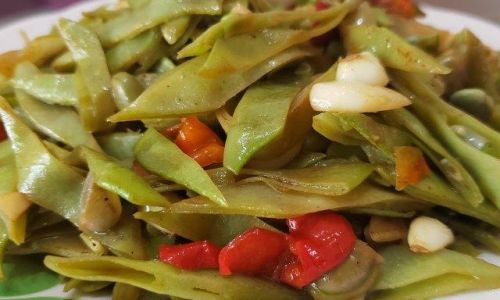
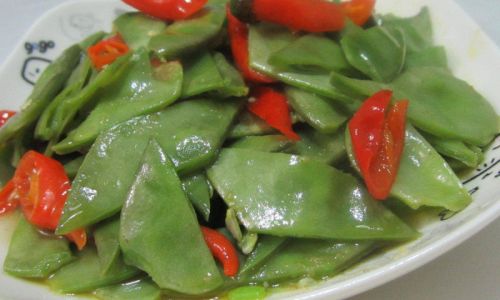
0 comments